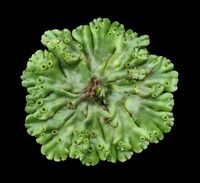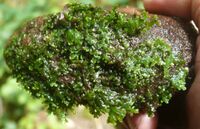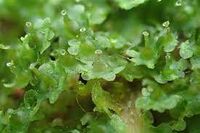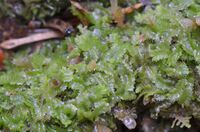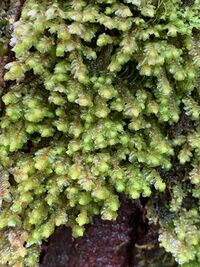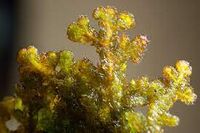Liverwort: Difference between revisions
Created page with "<b>Liverworts</b> are a class of terrestrial, non-vascular plants that can be found globally and consist of nearly 7000 species. They most commonly grow in moist, shaded areas..." |
No edit summary |
||
| (10 intermediate revisions by the same user not shown) | |||
| Line 1: | Line 1: | ||
<b>Liverworts</b> are a class of terrestrial, non-vascular plants that can be found globally and consist of nearly 7000 species. They most commonly grow in moist, shaded areas such as damp rocks, [[soil]], or tree trunks <ref> Britannica, The Editors of Encyclopaedia. "liverwort". Encyclopedia Britannica, 17 Apr. 2022, https://www.britannica.com/plant/liverwort. Accessed 2 April 2023. </ref>. Liverworts | <b>Liverworts</b> are a class of terrestrial, non-vascular plants that can be found globally and consist of nearly 7000 species. They are primitive bryophytes which requires them to use diffusion for means of acquiring water. They most commonly grow in moist, shaded areas such as damp rocks, [[soil]], or tree trunks <ref name = "B"> Britannica, The Editors of Encyclopaedia. "liverwort". Encyclopedia Britannica, 17 Apr. 2022, https://www.britannica.com/plant/liverwort. Accessed 2 April 2023. </ref>. Liverworts absorb water through mucilage<ref name= "ANBG"> What is a liverwort?, Australian National Botanic Gardens and Australian National Herbarium. 15 April 2008, https://www.anbg.gov.au/bryophyte/what-is-liverwort.html. Accessed 2 April 2023 </ref> which can be produced externally in slime papillae or internally in slime cells. This occurs at the growing point to prevent them from getting dehydrated. Liverworts serve as a source of food for [[animals]] and aid in the decay of logs and rocks. | ||
{| class="wikitable" style="margin: | Liverworts can be categorized into 2 groups: <b>thallose liverworts</b> or <b>leafy liverworts</b> <ref name = "LFG"> Liverworts Field Guide, https://mdc.mo.gov/discover-nature/field-guide/liverworts. Accessed 2 April 2023 </ref> depending on their growth form. All liverworts have chloroplasts and 90% have oil bodies <ref name = "ANBG"> </ref>. The functions of these oils bodies are widely unknown but vary in size and shape which makes for a great identification tool along with the specific aroma and taste they create. | ||
== Thallose Liverworts == | |||
<b> Thallose liverworts </b> grow in a flat structure, with rubbery leaves and can be found on soils with high moisture or damp rocks. The structure is formed by <b> thallus </b> which is a mass of uniform flattened cells, except for the capsules which contain sporophytes. Early species had thick and opaque structures but currently, the appearance of thallose liverworts can vary from thick and opaque to thin and clear <ref name = "LFG"></ref> depending on the genus. In some species, the thallus can also form branches that grow in a 'Y' formation. | |||
=== Complex Thallose Liverworts === | |||
<b> Complex thallose liverworts </b> have thalli where the thallus contains photosynthetic cells with tiny pores that lead to air chambers <ref name = "TH"> Thallose liverworts, Lepp, Heino. Australian National Botanic Gardens and Australian National Herbarium. 15 April 2008, https://www.anbg.gov.au/bryophyte/liverwort-thalose.html. Accessed 2 April 2023 </ref>. These pores are similar to stomata but are unable to be opened or closed and look like white dots on the upper thallus. Their main purpose is for gaseous exchange but cell functions within the thalli can be different depending on the species. | |||
The underside of the thallus is used to store water and nutrients, which makes these liverworts more drought-tolerant. Rhizoids are brown in color and are found on the center of the underside in packs<ref name = "BB">Basic Biology: An Introduction, Purcell, Adam. 19 May 2018.</ref>. They vary in shape but are essential for water absorption as they anchor the thallus. | |||
{| class="wikitable" style="margin: auto;" | |||
|- | |||
! Kingdom | |||
! Division | |||
! Class | |||
! Order | |||
! Family | |||
! Genus | |||
! Species | |||
! | |||
|- | |||
| rowspan="5" | Plantae | |||
| rowspan="5" | Marchantiophyta | |||
| rowspan="5" | Marchantiopsida | |||
| rowspan="5" | Marchantiales | |||
| rowspan="3" | <i>Marchantiaceae</i> | |||
| rowspan="3" | <i>Marchantia</i> | |||
| <i> M. berteroana </i> | |||
| [[File:Berteroana.jpeg|200px|Photo, Gordon KA Dickinson]] | |||
|- | |||
| <i> M. polymorpha </i> | |||
| [[File:polymorpha.jpeg|200px]] | |||
|- | |- | ||
| <i> M. tenella </i> | |||
| [[File:tenella.jpeg|200px]] | |||
|- | |- | ||
| | | <i>Lunalariaceae</i> | ||
| <i>Lunalaria</i> | |||
| <i> L. cruciata </i> | |||
| [[File:lunalaria.jpeg|200px]] | |||
|- | |- | ||
| <i>Ricciaceae</i> | |||
| <i>Riccia</i> | |||
| <i> R. limbata </i> | |||
| [[File:limbata.jpeg|200px]] | |||
|} | |} | ||
== Thallose Liverworts == | === Simple Thallose Liverworts === | ||
<b> | <b> Simple thallose liverworts </b> have thin thalli (typically 1 cell thick) that can be translucent. They don't have any differentiation in cell function which is what makes them different from complex thallose liverworts. They also don't have raised gametangia as it's produced on the underside of the tissue. | ||
{| class="wikitable" style="margin: auto;" | |||
|- | |||
! Kingdom | |||
! Division | |||
! Class | |||
! Order | |||
! Family | |||
! Genus | |||
! Species | |||
! | |||
|- | |||
| rowspan="4" | Plantae | |||
| rowspan="4" | Hepaticophyta | |||
| rowspan="4" | Jungermanniopsida | |||
| rowspan="3" | Jungermanniales | |||
| rowspan="2" | <i>Aneuraceae</i> | |||
| rowspan="2" | <i>Riccardia</i> | |||
| <i> R. latifrons </i> | |||
| [[File:latifrons.jpeg|200px]] | |||
|- | |||
| <i> R. chamedryfolia </i> | |||
| [[File:Chamedryfolia.jpeg|200px]] | |||
|- | |||
| <i>Pelliaceae</i> | |||
| <i>Pellia</i> | |||
| <i> P. epiphylla</i> | |||
| [[File:Epiphylla.jpeg|200px]] | |||
|- | |||
| Blasiales | |||
| <i>Blasiaceae</i> | |||
| <i>Blasia</i> | |||
| <i> B. pusilla</i> | |||
| [[File:pusilla.jpeg|200px]] | |||
|} | |||
== Leafy Liverworts == | |||
<b>Leafy liverworts </b> bear a similar resemblance to mosses and ferns as they have small leaves that overlap each other and grow in pairs on their stems. The leaves are quite small and are only ~1 mm in size with a single cell layer. The upper 2 layers of leaves are designed to be larger and are called <b> lateral leaves</b>. The <b>underleaves</b> are found on the underside and are smaller. Leafy liverworts are more common than thallose liverworts <ref name = "TH"> </ref> as they have more species and are often found in home gardens and public parks. | |||
{| class="wikitable" style="margin: auto;" | |||
|- | |||
! Kingdom | |||
! Division | |||
! Class | |||
! Order | |||
! Family | |||
! Genus | |||
! Species | |||
! | |||
|- | |||
| rowspan="4" | Plantae | |||
| rowspan="4" | Hepaticophyta | |||
| rowspan="4" | Jungermanniopsida | |||
| rowspan="3" | Jungermanniales | |||
| rowspan="1" | <i>Geocalycaceae</i> | |||
| rowspan="1" | <i>Geocalyx</i> | |||
| <i> G. Graveolens </i> | |||
| [[File:graveolens.jpeg|200px]] | |||
|- | |||
| <i>Scapaniaceae</i> | |||
|<i>Scapania</i> | |||
| <i> S. saxicola</i> | |||
| [[File:saxicola.jpeg|200px]] | |||
|- | |||
|<i>Lophocoleaceae</i> | |||
|<i> Lophoecolea </i> | |||
|<i> L. heterophylla </i> | |||
| [[File:lophocolea.jpeg|200px]] | |||
|- | |||
| Ptilidiales | |||
| <i>Ptilidiaceae</i> | |||
| <i> Ptilidium </i> | |||
| <i>P. ciliare</i> | |||
| [[File:ciliare.jpeg|200px]] | |||
|} | |||
== Life Cycle == | == Life Cycle == | ||
Since liverworts do not have a vascular system, they reproduce through the | Since liverworts do not have a vascular system, they reproduce through a small, ephemeral sporophyte <ref name = "ANBG"> </ref>. The sporophyte is a diploid, which is formed when the zygote is fertilized and separates mitotically <ref name = "PS"> Plant Systematics (Second Edition), Simpson, Michael G.. 2010. https://doi.org/10.1016/B978-0-12-374380-0.50003-8. Accessed May 07, 2023. </ref>. Haploid cells are released from the sporangium all at once and are distributed by wind or water, where they germinate into thalli gametophytes. | ||
The sporangia doesn't survive for much longer after dispersal. The gametophytes fall onto different plants, attaching themselves to individual plants, where male and female gametangia<Ref>Phephu, N. (2012, April). Marchantia berteroana . Pza.sanbi.org; South African National Biodiversity Institute. https://pza.sanbi.org/marchantia-berteroana</ref> develop as most liverworts are dioecious. Once developed, male gametes will fertilize the female gametangium to create a zygote. This zygote will stay attached to the parent while forming into a sporophyte and create it's own spore-producing cells. The sporangium has a protective case <ref> Campbell, Douglas Houghton. “The Classification of the Liverworts.” The American Naturalist, vol. 46, no. 551, Nov. 1912, pp. 684–695, https://doi.org/10.1086/279318. Accessed 1 May 2023.</ref>around it called a <b> calyptra </b> that only young plants typically retain. Once these cells undergo meiosis, they will form spores, and thus restart the cycle. | |||
Some thalloid liverworts reproduce asexually through gemmae cups. Gemmae cups produce gemmae which form new plants through diaspores. They are carried through water droplets when they fall into the gemmae cup. This will produce a plant that is identical to the parent plant. | |||
Latest revision as of 11:12, 12 May 2023
Liverworts are a class of terrestrial, non-vascular plants that can be found globally and consist of nearly 7000 species. They are primitive bryophytes which requires them to use diffusion for means of acquiring water. They most commonly grow in moist, shaded areas such as damp rocks, soil, or tree trunks [1]. Liverworts absorb water through mucilage[2] which can be produced externally in slime papillae or internally in slime cells. This occurs at the growing point to prevent them from getting dehydrated. Liverworts serve as a source of food for animals and aid in the decay of logs and rocks.
Liverworts can be categorized into 2 groups: thallose liverworts or leafy liverworts [3] depending on their growth form. All liverworts have chloroplasts and 90% have oil bodies [2]. The functions of these oils bodies are widely unknown but vary in size and shape which makes for a great identification tool along with the specific aroma and taste they create.
Thallose Liverworts
Thallose liverworts grow in a flat structure, with rubbery leaves and can be found on soils with high moisture or damp rocks. The structure is formed by thallus which is a mass of uniform flattened cells, except for the capsules which contain sporophytes. Early species had thick and opaque structures but currently, the appearance of thallose liverworts can vary from thick and opaque to thin and clear [3] depending on the genus. In some species, the thallus can also form branches that grow in a 'Y' formation.
Complex Thallose Liverworts
Complex thallose liverworts have thalli where the thallus contains photosynthetic cells with tiny pores that lead to air chambers [4]. These pores are similar to stomata but are unable to be opened or closed and look like white dots on the upper thallus. Their main purpose is for gaseous exchange but cell functions within the thalli can be different depending on the species. The underside of the thallus is used to store water and nutrients, which makes these liverworts more drought-tolerant. Rhizoids are brown in color and are found on the center of the underside in packs[5]. They vary in shape but are essential for water absorption as they anchor the thallus.
Simple Thallose Liverworts
Simple thallose liverworts have thin thalli (typically 1 cell thick) that can be translucent. They don't have any differentiation in cell function which is what makes them different from complex thallose liverworts. They also don't have raised gametangia as it's produced on the underside of the tissue.
Leafy Liverworts
Leafy liverworts bear a similar resemblance to mosses and ferns as they have small leaves that overlap each other and grow in pairs on their stems. The leaves are quite small and are only ~1 mm in size with a single cell layer. The upper 2 layers of leaves are designed to be larger and are called lateral leaves. The underleaves are found on the underside and are smaller. Leafy liverworts are more common than thallose liverworts [4] as they have more species and are often found in home gardens and public parks.
Life Cycle
Since liverworts do not have a vascular system, they reproduce through a small, ephemeral sporophyte [2]. The sporophyte is a diploid, which is formed when the zygote is fertilized and separates mitotically [6]. Haploid cells are released from the sporangium all at once and are distributed by wind or water, where they germinate into thalli gametophytes.
The sporangia doesn't survive for much longer after dispersal. The gametophytes fall onto different plants, attaching themselves to individual plants, where male and female gametangia[7] develop as most liverworts are dioecious. Once developed, male gametes will fertilize the female gametangium to create a zygote. This zygote will stay attached to the parent while forming into a sporophyte and create it's own spore-producing cells. The sporangium has a protective case [8]around it called a calyptra that only young plants typically retain. Once these cells undergo meiosis, they will form spores, and thus restart the cycle.
Some thalloid liverworts reproduce asexually through gemmae cups. Gemmae cups produce gemmae which form new plants through diaspores. They are carried through water droplets when they fall into the gemmae cup. This will produce a plant that is identical to the parent plant.
- ↑ Britannica, The Editors of Encyclopaedia. "liverwort". Encyclopedia Britannica, 17 Apr. 2022, https://www.britannica.com/plant/liverwort. Accessed 2 April 2023.
- ↑ 2.0 2.1 2.2 What is a liverwort?, Australian National Botanic Gardens and Australian National Herbarium. 15 April 2008, https://www.anbg.gov.au/bryophyte/what-is-liverwort.html. Accessed 2 April 2023
- ↑ 3.0 3.1 Liverworts Field Guide, https://mdc.mo.gov/discover-nature/field-guide/liverworts. Accessed 2 April 2023
- ↑ 4.0 4.1 Thallose liverworts, Lepp, Heino. Australian National Botanic Gardens and Australian National Herbarium. 15 April 2008, https://www.anbg.gov.au/bryophyte/liverwort-thalose.html. Accessed 2 April 2023
- ↑ Basic Biology: An Introduction, Purcell, Adam. 19 May 2018.
- ↑ Plant Systematics (Second Edition), Simpson, Michael G.. 2010. https://doi.org/10.1016/B978-0-12-374380-0.50003-8. Accessed May 07, 2023.
- ↑ Phephu, N. (2012, April). Marchantia berteroana . Pza.sanbi.org; South African National Biodiversity Institute. https://pza.sanbi.org/marchantia-berteroana
- ↑ Campbell, Douglas Houghton. “The Classification of the Liverworts.” The American Naturalist, vol. 46, no. 551, Nov. 1912, pp. 684–695, https://doi.org/10.1086/279318. Accessed 1 May 2023.
